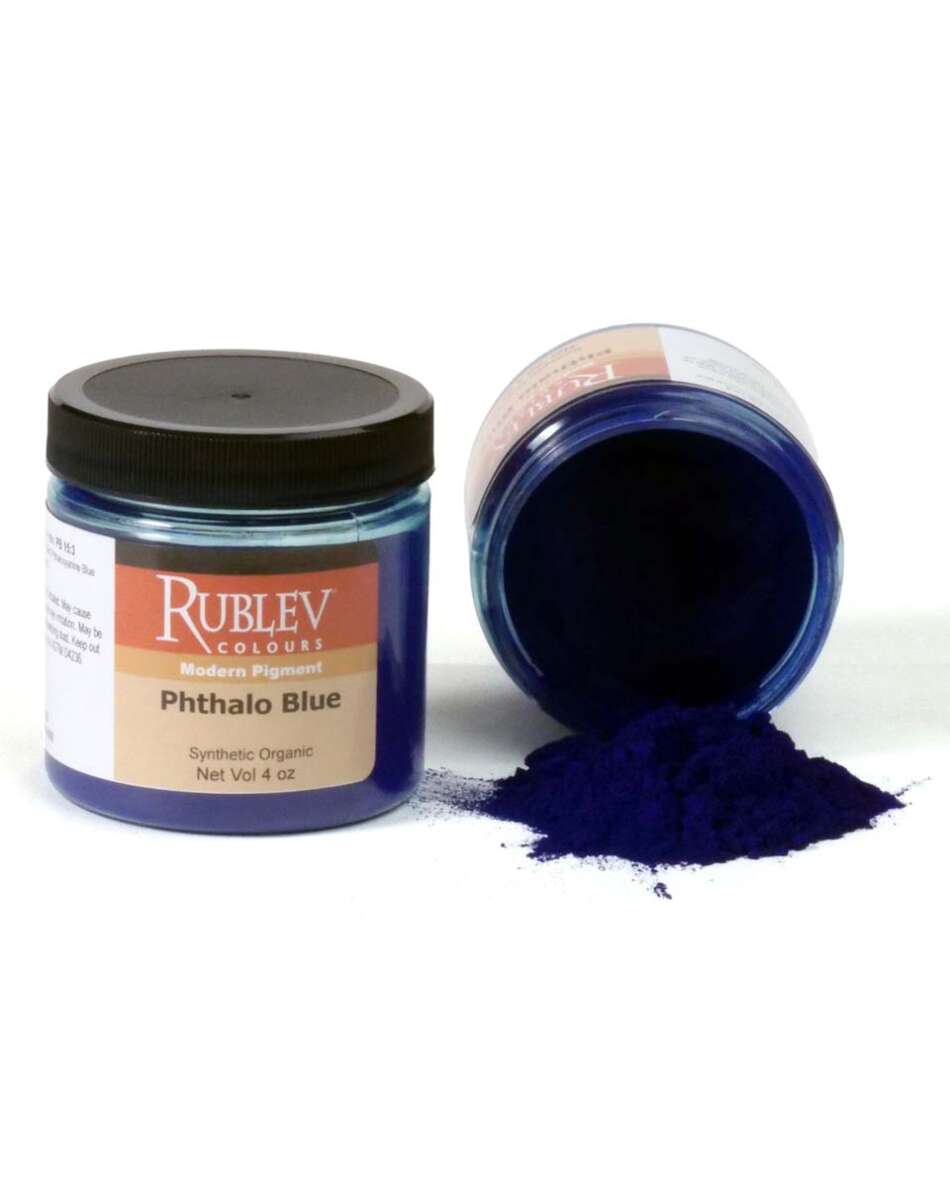Phthalo Blue Pigment: A Vibrant and Durable Choice for Artists
Phthalo Blue
Phthalo Blue, a vibrant and enduring synthetic pigment, has become a cornerstone in the palettes of artists worldwide. Known for its intense chromatic strength and exceptional lightfastness, this pigment offers unparalleled versatility and reliability. Its synthetic origin ensures consistent quality and availability. At the same time, its compatibility with various media—ranging from oils to acrylics and watercolors—enables artists to explore a broad spectrum of creative possibilities. Non-toxic and easy to work with, Phthalo Blue provides a brilliant hue and maintains its integrity over time, making it an indispensable choice for both professional and amateur artists seeking to create lasting works of art.
| Pigment Names | |
| Common Names: | English: Phthalo Blue French: Bleu Phtalo German: Phthaloblau Italian: Blu Ftalico Spanish: Azul Ftalocianina Dutch: Phtaloblauw Russian: Фталоцианиновый синий (Ftalotsianinovyy siniy) Japanese: フタロシアニンブルー (Futaroshianin Burū) Chinese: 酞菁蓝 (Tài jīng lán) |
| Alternate Names: | Monastral Blue Winsor Blue Helio Blue Thalo Blue Copper Phthalocyanine Blue |
Origin and History
Phthalocyanine blue, also known as Phthalo Blue, is a synthetic pigment developed in the early 20th century. Discovered accidentally in 1927 during experiments aimed at synthesizing phthalimide, phthalocyanine blue quickly gained prominence due to its vivid hue and remarkable stability. In 1937, DuPont started producing copper phthalocyanine blue in the USA under the trade name Monastral Blue after it was launched in Great Britain and Germany in 1935. Its introduction revolutionized the art and printing industries, providing a reliable and vibrant blue pigment that surpassed many traditional blues in terms of durability and color intensity. Today, it remains a staple in the palettes of artists and manufacturers worldwide.
Pigment Source
Phthalocyanine blue is derived from phthalocyanine, a complex organic compound with a copper ion at its core. The pigment is produced by heating phthalic anhydride, urea, and copper chloride or copper sulfate at high temperatures. The resulting compound is a crystalline, intensely colored substance that can be finely ground to produce the pigment. The synthetic nature of phthalocyanine blue ensures consistent quality and availability, unlike many natural pigments that can be subject to variability and scarcity.
The first forms of phthalocyanine blue, α (alpha) phase, did not form stable dispersions, especially in mixtures with rutile titanium, where the blue pigment tended to flocculate. The β (beta) phase and the improved stabilized α phase were more stable. Today, five different polymorphs have been identified—α, β, η, γ and χ.
Permanence and Compatibility
Phthalocyanine blue is renowned for its exceptional permanence and lightfastness, making it a highly stable pigment under various conditions. It resists fading and degradation over time, even when exposed to strong sunlight or adverse environmental factors. This stability makes it compatible with various media, including oil, acrylic, watercolor, and tempera. It also mixes well with other pigments, allowing artists to achieve a broad spectrum of colors without compromising the integrity of the final product.
Oil Absorption and Grinding
The oil absorption rate of phthalocyanine blue is moderate to high, requiring 52 grams of linseed oil for each 100 grams of pigment. A balanced amount of oil is required to achieve the desired consistency without becoming too runny or thick. The pigment’s fine particle size ensures smooth grinding and dispersion in the chosen medium, resulting in a uniform, homogenous paint. Artists appreciate its ability to maintain a high chromatic strength even when used in small quantities.
Toxicity
Phthalocyanine blue is considered non-toxic and safe for use in artistic and industrial applications. Under normal usage conditions, it does not pose significant health risks through skin contact, inhalation, or ingestion. However, as with all pigments, it is advisable to handle phthalocyanine blue with care, using appropriate protective equipment such as gloves and masks, especially during processes that generate dust or fumes.
For more information on handling pigments safely, please visit How to Safely Handle Art Materials and Pigments.
| Pigment Information | |
| Color: | Blue |
| Pigment Classification: | Synthetic Organic |
| Colour Index: | Pigment Blue 15:3 (74160) |
| Chemical Name: | Cu-Phthalocyanine Blue, beta modified |
| Chemical Formula: | C32H16CuN8 |
| Structural Formula: |  |
| CAS No.: | 147-14-8 |
| Series No.: | 3 |
| FDA Approved: | No |
| ASTM Lightfastness | |
| Acrylic: | I |
| Oil: | I |
| Watercolor: | I |
| Physical Properties | |
| Specific Surface: | 54 m2/g |
| Density: | 1.5 g/cm3 |
| Bulk Density: | 3.5 l/kg |
| Refractive Index: | 1.50–1.55 |
| Oil Absorption: | 52 grams oil / 100 grams pigment |
| Heat Resistance: | 180° C |
| Health and Safety | No acute or known chronic health hazards are associated with this product’s anticipated use (most chemicals are not thoroughly tested for chronic toxicity). Protect yourself against potentially unknown chronic hazards of this and other chemical products by keeping them out of your body. Do this by avoiding ingestion, excessive skin contact, and inhaling spraying mists, sanding dust, and vapors from heating. Conforms to ASTM D-4236. |
For a detailed explanation of the terms in the table above, please visit Composition and Permanence.
| SKU | 418-11 |
|---|---|
| Brand | Rublev Colours |
| Vendor | Natural Pigments |
| Processing Time | Usually ships the next business day. |
| Color | Blue |
| Pigment Type | Organic, Synthetic |
Health & Safety: There are no acute or known chronic health hazards with the anticipated use of this product (most chemicals are not thoroughly tested for chronic toxicity). Protect yourself against potentially unknown chronic hazards of this and other chemical products by avoiding ingestion, excessive skin contact, and inhaling spraying mists, sanding dust, and concentrated vapors from heating. Contact us for further information or consult the SDS for more information. Conforms to ASTM D-4236.



